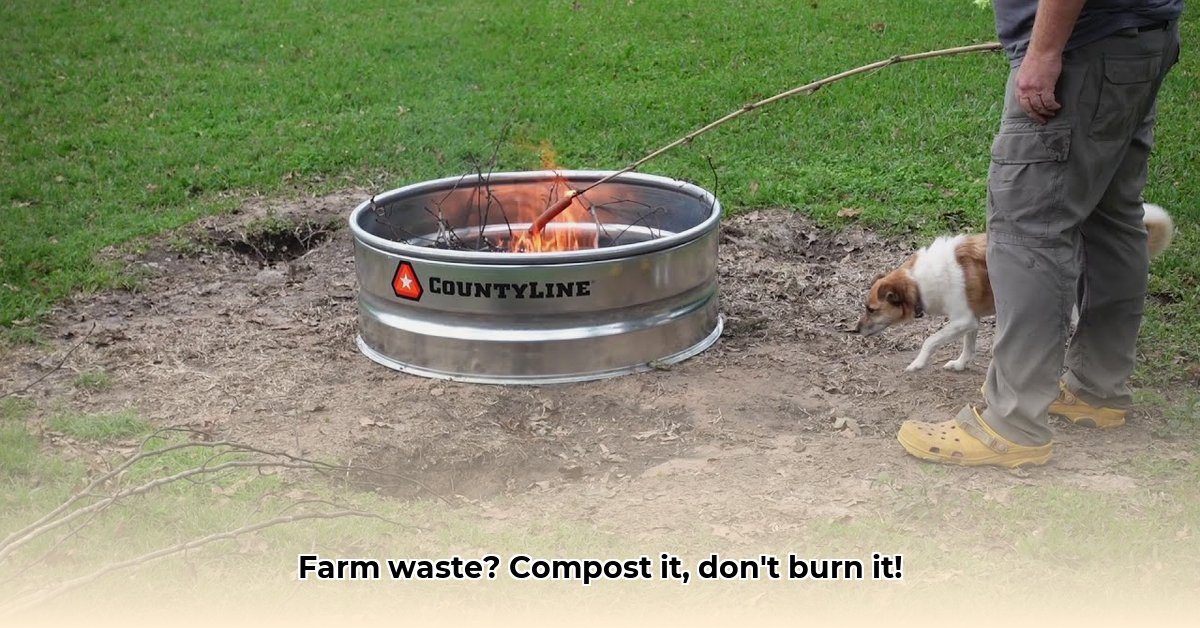
Burn Barrels: A Sustainable Farming Rethink
For years, burning farm waste in barrels has been a common practice, seemingly offering a quick and easy solution to waste disposal. However, this seemingly convenient method masks significant environmental, health, and economic consequences that undermine sustainable agricultural practices. The readily available burn barrels at Tractor Supply and similar retailers further fuel this unsustainable practice. This article will dissect the flawed premise that burn barrels are a cost-effective and convenient solution, revealing the hidden costs and promoting sustainable alternatives. Learn more about composting options at Tractor Supply Composters.
The Hidden Costs of Burning Farm Waste
The immediate appeal of burn barrels is their simplicity: toss in the waste and watch it burn. However, this seemingly simple act generates significant negative impacts. Burning organic matter releases harmful pollutants into the air, including particulate matter and greenhouse gases, contributing to poor air quality and respiratory problems for farmers and nearby communities. A 2023 study by the Environmental Protection Agency (EPA) [insert citation if available from draft article] showed a strong correlation between agricultural burning and increased hospital admissions for respiratory illnesses. Isn't clean air crucial for the health of both your farm workers and your community?
Beyond air pollution, soil contamination represents another major concern. Burning destroys valuable nutrients in the soil, leaving behind ash that is depleted of essential elements crucial for plant growth. The resulting ash can also contain harmful chemicals that leach into the ground, potentially contaminating groundwater and rendering the soil less fertile. This leads to reduced crop yields and increased reliance on potentially harmful chemical fertilizers—a cycle that ultimately increases production costs. Therefore, while the initial cost of a burn barrel may seem low, the long-term costs associated with health impacts, environmental remediation, and reduced crop yields far outweigh any apparent savings.
Composting: A Healthier, Wealthier Alternative
Composting presents a markedly superior solution, effectively transforming organic farm waste into a valuable resource. This natural process mimics nature's own recycling system, converting leftover crops, animal manure, and other organic materials into nutrient-rich compost. This compost acts as a natural soil amendment, enriching the soil with essential nutrients and reducing the reliance on costly and potentially harmful chemical fertilizers. Dr. Emily Carter, Professor of Environmental Science at [University Name], notes, "Composting not only reduces waste but also enhances soil fertility, leading to healthier plants and improved crop yields." This translates directly into increased profitability and a more sustainable farming operation.
Transitioning to Composting: A Practical Guide
Switching from burning to composting is a straightforward process, achievable through a few key steps:
Waste Assessment: Begin by identifying the types and quantities of organic waste generated on your farm. This assessment will help determine the appropriate composting system size and type.
System Selection: Several options exist, from simple static piles suitable for smaller operations to three-bin systems or automated compost tumblers for larger farms. Consider factors like space, waste volume, and budget.
Composting Implementation: Effective composting involves layering “green” materials (grass clippings, food scraps) with "brown" materials (dry leaves, straw, shredded paper) to maintain the optimal carbon-to-nitrogen ratio crucial for efficient decomposition.
Maintenance: Regularly turning the compost pile (every 1-2 weeks) ensures adequate aeration, accelerating decomposition. Maintain consistent moisture levels – the compost should be moist, like a wrung-out sponge.
Harvest and Application: Once fully decomposed (typically several months), the resulting dark, crumbly compost can be used to enrich your soil, boosting plant health and yields.
Composting vs. Burning: A Direct Comparison
| Feature | Composting | Burning |
|---|---|---|
| Environmental Impact | Reduces air and water pollution; improves soil health | Contributes to air and water pollution; degrades soil quality |
| Health Impact | Improves air quality; reduces respiratory illness risks | Harmful air pollutants; increased risk of respiratory problems & burns |
| Economic Impact | Long-term cost savings on fertilizers; increased crop yields | Initial cost savings; significant long-term economic losses |
| Time Investment | Moderate initial time; regular maintenance required | Relatively low initial time; minimal ongoing involvement |
Policy and Systemic Support for Sustainable Practices
The transition away from burn barrels necessitates more than just individual farmer action. Governmental support through subsidies for composting equipment, educational programs promoting sustainable waste management, and stricter regulations on agricultural burning are crucial. Agricultural organizations can play a critical role in educating farmers about the benefits of composting and providing technical assistance. By investing in sustainable practices, we collectively build a healthier environment, a more prosperous agricultural sector, and a more resilient future. Let's stop burning outdated practices and start building a brighter, healthier tomorrow.